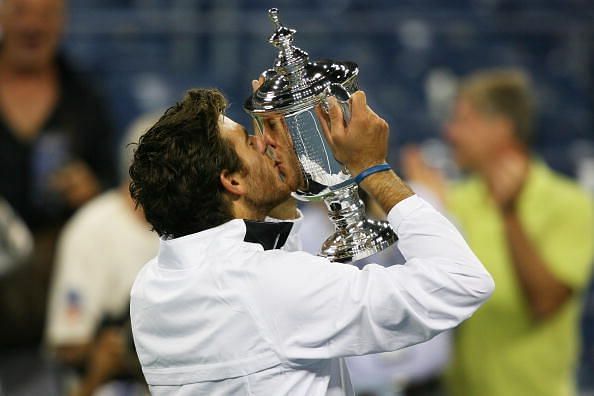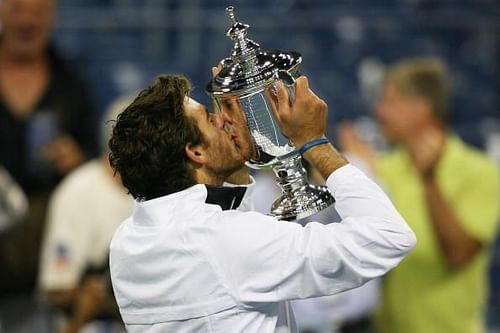
The Incredible Story of Juan Martin Del Potro

The date was 14th September 2009. The stage was set for five-time defending champion Roger Federer to become the first man to win a sixth consecutive US Open title since 1925. At the time, he was also vying to be the first man in the open era to win slams on all three surfaces: clay, grass and hard in one calendar year (a feat which has since been accomplished only once by Rafael Nadal in 2010).
The Swiss were also on a 41-match winning streak at Flushing Meadows prior to the final. At 28, he was already an icon of the game and just one step away from writing his name in the history books yet again. But, spectacularly, it wasn’t meant to be for Federer as a 20-year-old Argentine, then ranked #6 in the world, prevailed in 5 grueling sets to win his first grand slam, presumably one of many for the youngster.
Last month, Juan Martin Del Potro walked on to the Arthur Ashe Stadium court once again, 9 years on, for only his second grand slam final. His journey from his first grand slam final to his second is as devastating and infuriating as it is intrepid and admirable.
That win at Flushing Meadows makes Del Potro one of eighteen men to have won a Grand Slam in the twenty-first century and one of seven men to have won one post-2006. It also makes him one of two players (the other being Djokovic who did it in US Open 2011) to beat both Nadal and Federer in a grand slam tournament.
Winning even a solitary slam is quite the achievement but to do so in an era in which Federer, Nadal, and Djokovic dominated the tour makes it all the more remarkable. The esteemed company Del Potro finds himself in is no small thing and the future looked bright for the young Argentine.
2010 was supposed to be Del Potro’s year and he went into the Australian Open seeded 4th. The world was ready for Juan to make his mark on the tour but unfortunately, the world had to wait. His trademark bullet forehand, for which he applied lead tape to the head of the racket so that he could execute it with an incredible amount of power, was probably his most effective weapon but also proved to be the root cause of his downfall. He developed tendonitis in his right wrist which proved to be a chronic injury and eventually required surgery.
He dropped out of most of the 2010 season and his ranking plummeted from 4th in the world to no. 485 within a year. 2011 proved to be a year of recuperation as the Argentine slowly worked his way up the rankings picking up 2 titles on the way. Shortly after, 2012 proved to be a good year for Juan as he broke back into the top 10, won 4 titles and an Olympic bronze for his country that showered him with love and admiration every time he walked onto the court.
2013 saw more of the same from Del Potro as he continued to pick up points and titles and also came out on the wrong side of a brutal Wimbledon semi-final against Djokovic which lasted for five sets and 4 hours and 43 minutes making it the longest semi-final in Wimbledon history at the time.
That match showed the rest of the world that Del Potro may have suffered setbacks in the last few years but was still one to watch and could still raise his game for these big occasions and by 2014 he was ranked 4th in the world once again after spending four years to try to get back to the level he had reached after his monumental win in New York.
The world was all set once again, to see Juan challenge the very best the game had to offer and win big tournaments and Grand Slams. However, after what was not a spectacular start to the year, things became agonizing for the Argentine as he was forced to retire in the first round of the Dubai Open due to another injury in his wrist which began an excruciating set of injuries and operations.
He dropped the rest of the 2014 season and came back in 2015 but after some unconvincing performances he felt the strain on his wrist once again and dropped the rest of 2015 also for a third surgery. By 2016 he had undergone four operations on his wrist and fallen to no.1042 in the rankings. Here was a man that had seen one of the highest moments an athlete could see at age 20 and fell to the darkest moment an athlete could fall to at age 26.
In his own words: "I couldn't find a way to fix my wrist problems. I (was) suffering a lot. I got depressed for a couple of months, also. I didn't get the chance to feel better with myself, to do this again. That was the bad moment for me." The 6 foot 6 Argentine built like a god, known for his power and aggression, an Olympic bronze medalist and former Grand Slam champion had been subdued by a chronic injury in his wrist: enough to lead any ordinary man to hang up his boots.
But Juan Martin Del Potro is no ordinary man. His was a spirit that could not be broken. After months of strenuous and agonizing physical therapy, he came back to the tour in February 2016. In two years, he flew under the radar, picked up some points and titles and even won the Olympic silver in Rio in 2016 despite being the overwhelming underdog. He then broke back into the top 10 by February 2018, exactly two years since his comeback.
Finally, 2018 is proving to be the year Delpo finally catches a break. Winning back to back tournaments first in Acapulco and then at Indian Wells beating Roger Federer in the final which was surely one of the matches of the year. He then went on to play strong tournaments at Roland Garros and Wimbledon bowing out to Rafael Nadal in both, playing a 5 set epic in the quarter-final of Wimbledon which was another contender for match of the year.
This was a match of incredibly tiny margins and if a few things had gone his way el Potro would have taken it in the fifth. After playing an almost flawless tournament at Flushing Meadows dropping just one set and forcing world no. 1 and 2018 foe Rafael Nadal to retire after two sets, 9 years after his breakthrough win on this very court, he was in another grand slam final.
The final was less than ideal for Juan. He lost to Novak Djokovic, who himself has been on somewhat of a comeback trail, 6-3 7-6 6-3 but the match was fought a lot harder than the scoreline suggested. The 95-minute long second set could have flown either way and the 20-minute long 8th game showcased some of Del Potro’s best attacking, powerful, aggressive tennis. But Djokovic was able to grind the win out and as Del Potro buried his head into his towel and wept, as he was consoled by friend and opponent on the day, the hearts of tennis fans all around the world melted.
For this was a man that was sent to athletic limbo if you would like, a man that suffered injury after injury and was written off by one and all. Yet, this year saw him win two more tournaments, play two of the matches of the year against two of the greatest players to ever play the game, reach a career-high ranking of no.3 and reach a grand slam final. This tournament and this year was a sign that Juan is back.
Perhaps his story is a testament to why we love athletes so much. It is because they unapologetically follow their dreams and refuse to give up on them with a child-like stubbornness. This is what makes Del Potro’s story the feel-good story of this generation of men’s tennis. A man with an indomitable spirit that faced setback after setback and came out on top. Here’s to sincerely hoping that there’s more to come from the Argentine powerhouse.